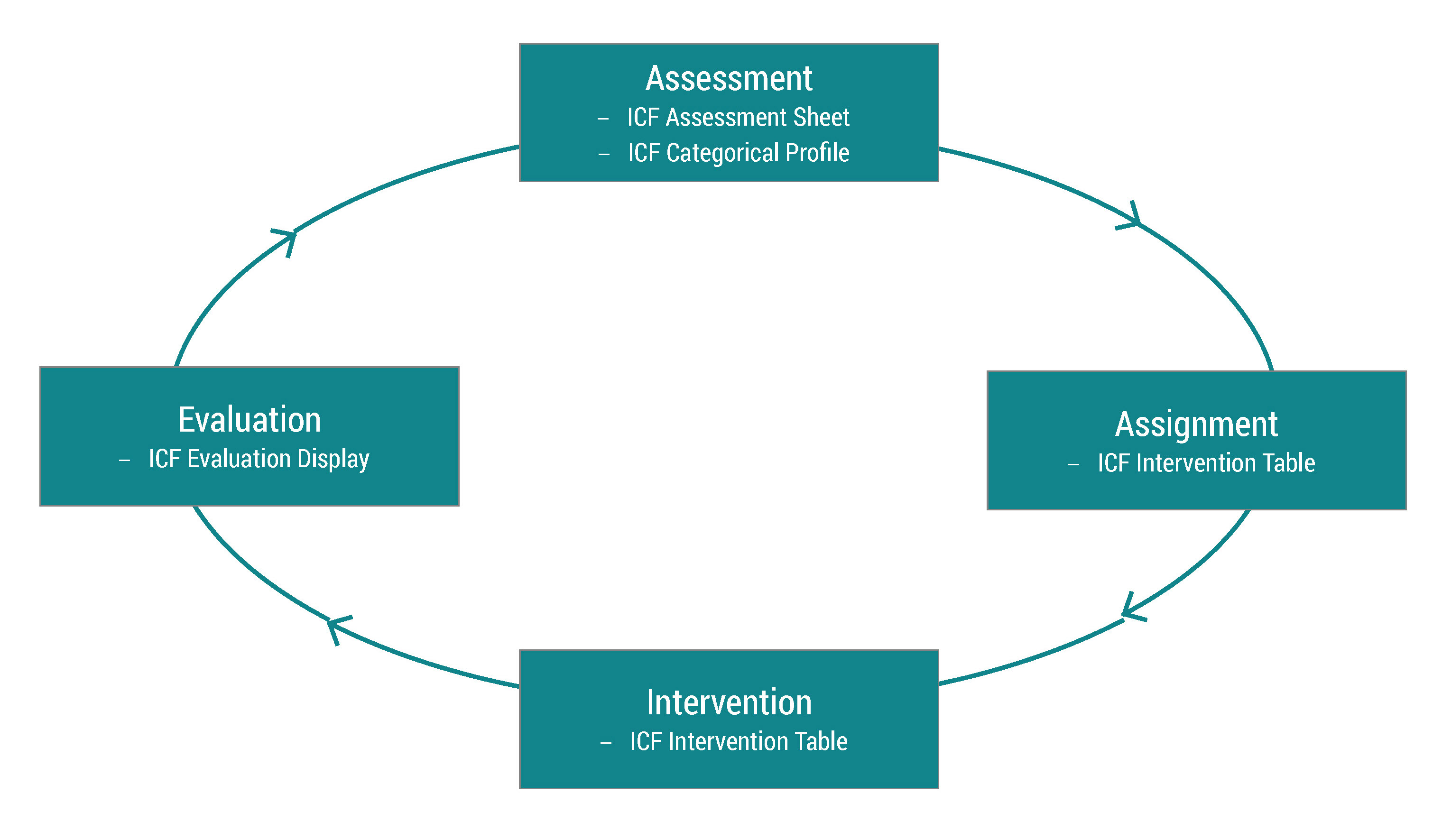Introduction to ICF-based Documentation Tools and Rehab-Cycle
The Rehab-Cycle®
To facilitate the use of the ICF in clinical practice, it is essential to have ICF-based tools that could be integrated into the existing processes. In the rehabilitation setting, ICF-based tools can be employed in rehabilitation management - the multidisciplinary team can use them to comprehensively describe the functioning of persons experiencing or likely to experience disability, to guide the planning of functioning-oriented rehabilitation services and evaluate changes in the functioning status over a certain time period.
Rehabilitation management can be characterized with a problem-solving approach. One such approach based on the ICF is the rehabilitation cycle, called Rehab-Cycle®. The Rehab-Cycle® can facilitate the structuring, organization and documentation of the rehabilitation process, as well as help the professionals involved in a patient's rehabilitation with coordinating their actions. This iterative process includes four key elements: 1) assessment, 2) assignment, 3) intervention and 4) evaluation.

The Rehab-Cycle®® and the corresponding ICF-based documentation tools
Overview of the ICF-based documentation tools
For each element of the Rehab-Cycle®, ICF-based documentation tools have been developed that also take into account the ICF Core Sets. These tools aim to facilitate the documentation and planning of rehabilitation services. The ICF-based documentation tools are the ICF Assessment Sheet, ICF Categorical Profile, ICF Intervention Table and the ICF Evaluation Display.
These tools encouraged interdisciplinary communication in that they required the rehabilitation professionals involved to discuss and determine the overall health status of a person at the begining of rehabilitation (ICF Assessment Sheet), to decide on a mutual rating for each ICF category and set shared goals (ICF Categorical Profile), determine the appropriate interventions and allocate the respective responsibilities for conducting the interventions (ICF Intervention Sheet), and discuss and conclude goal achievement (ICF Evaluation Display). The set of ICF categories employed in the assessment, intervention planning and re-evaluation provides a common language for the various rehabilitation professionals involved.
In addition, the ICF-based documentation tools facilitate transparent documentation and information exchange between the rehabilitation professionals in the team.
Literature
- Cieza A, Geyh S, Chatterji S, Kostanjsek N, Ustun B Stucki G. ICF linking rules: an update based on lessons learned J Rehabil Med. 2005; 37(4): 212-218.
- Finger ME, Selb M, De Bie R, Escorpizo R. Using the International Classification of Functioning, Disability and Health in physiotherapy in multidisciplinary vocational rehabilitation: A case study of low back pain.Physiother Res Int. 2014 Apr 15. Epub ahead of print.
- Glässel A, Rauch A, Selb M, Emmenegger K, Lückenkemper M, Escorpizo R. A case study on the application of the International Classificaiton of Functioning, Disability and Health (ICF)-based tools for vocational rehabilitation in spinal cord injury. Work. 2012; 41(4): 465-474.
- Peter C, Rauch A, Cieza A, Geyh S. Stress, internal resources and functioning in a person with spinal cord disease. NeuroRehabilitation. 2012;30(2):119-130.
- Rauch A, Cieza A, Stucki G. How to apply the International Classification of Functioning, Disability and Health (ICF) for rehabilitation management in clinical practice. Eur J Phys Rehabil Med 2008; 44:329-342.
- Rauch A, Bickenbach J, Reinhardt J, Geyh S, Stucki G. The utility of the ICF to identify and evaluate problems and needs in participation in spinal cord injury. Top Spinal Cord Inj Rehabil. 2010; 15(4); 72-86.
- Rauch A, Escorpizo R, Riddle D, Eriks-Hoogland I, Stucki G, Cieza A. Using a case report of a patient with spinal cord injury to illustrate the application of the International Classification of Functioning, Disability and Health (ICF) during patient management. Phys Therapy. 2010; 90(7): 1039-1052.
- Rauch A, Baumberger M, Moise FG, von Elm E, Reinhardt JD. Rehabilitation needs assessment in persons with spinal cord injury following the 2010 earthquake in Haiti: a pilot study using an ICF-based tool. J Rehabil Med. 2011; 42: 969-975.
- Steiner WA, Ryser L, Huber E, Uebelhart D, Aeschlimann A, Stucki G. Use of the ICF model as a clinical problem-solving tool in physical therapy and rehabilitation medicine. Phys Ther. 2002; 82(11): 1098-1107.
- Stucki G, Cieza A. The International Classification of Functioning, Disability and Health (ICF) in physical and rehabilitation medicine. Editorial. Eur J Phys Rehab Med 2008; 44: 299-302.
- Stucki G, Kostanjsek N, Üstün B, Cieza A. ICF-based classification and measurement of functioning. Eur J Phys Rehab Med. 2008; 44: 315-328.